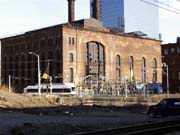Robert Costa, whose company arranges art exhibitions, thinks the development of the Jersey City arts district needs a different emphasis.
“I think we should go for galleries,” said Costa, taking a contrary view from the City Planning Department, which is currently formulating a new plan for the creation of an arts district between the Newport section and downtown.
Previously known as the WALDO district because of the “work and live district overlay” zoning given to the area by the city in 1990s, the district has recently been renamed the Power House Arts District (PHAD). The development plan currently being worked on by the city calls for new housing in the area, with 10 percent set aside to be low-income housing for artists. The trend is starting with a restoration project already underway at 140 Bay St.
Planning Department Director Robert Cotter said last Monday that he had received from Costa a report detailing Costa’s views on PHAD development. Cotter stated the report was thorough and would be included in all considerations of the planning department on the arts district development.
Maryann Bucci-Carter, a supervising planner for the Jersey City Planning Department and the chief developer of the PHAD development plan, affirmed Cotter’s statements on Costa’s proposed plans for PHAD.
“I can’t comment on any one alternate plan for the arts district,” Bucci-Carter said on Wednesday during a phone interview. “I can say we have gotten a lot of good insights from other people’s input into the development of the plan.”
Costa disagrees with the city’s plans as they have been so far formulated.
“The city seems to be working from an older model of thinking,” said Costa, the owner of Art in Plain Sight, a Jersey-City based firm which arranges art exhibitions in public spaces. “In the early 1990s, artists wanted to live where they work. There has been a shift away from that recently, and now artists seem to want to have a separate work space from where they live.”
Costa believes the planning department’s desire to bring in new housing, with a portion set aside for artists, is a bad idea.
“The area will become gentrified and the rents will go up,” Costa noted, adding the increased rents will make living in the PHAD, for artists, very difficult. Costa sees as an alternative in attracting galleries to the arts district. “The galleries mixed in with work space for artists would be better,” said Costa. “Once you have a critical mass on the galleries, other high end stores and eateries will be attracted.”
Costa proposes 50 art galleries in the PHAD as “critical mass.”
When asked if there was any connection between Costa’s strong advocacy of galleries in the PHAD and his business, Costa stressed that his company only sets up art exhibitions in public spaces such as libraries and the lobbies of office buildings.
Costa said that the art galleries in the new district could host school events, classes, and other programs.
Bucci-Carter said the planning department was following the report by the Urban Land Institute on how to best develop the arts district. The ULI is group of volunteer developers, architects, and other building professionals who examine sections of cities for their viability for redevelopment.
“The ULI report was done by a variety of experts in the arts, development and other facets of an arts district,” said Bucci-Carter. “We would be looking to them guidance.”
The ULI report, done a few years ago, calls for affordable housing for artists in any Jersey City arts district development.
Cotter said the Planning Department’s work on a development plan for PHAD was nearly half completed. He added the plan, when finished, would be displayed at a public meeting.
“We might have something by the middle of May, but it’s looking more like June,” said Bucci-Carter in regards to a completed PHAD development plan.
Meanwhile, Costa continues to have faith that a Jersey City arts district will be a success.
“I came to Jersey City because I thought it was the next big thing,” said Costa in regards to setting up his business in Jersey City. “It would be a shame to lose it.”
Our Digital Archive from 2000 – 2016
